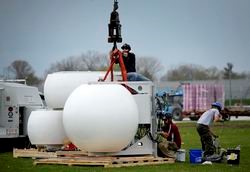Verizon Installs New Technology At Indy Motor Speedway For IndyCar Fans
 |
| Verizon Matsing Ball |
Indiana's first permanent installations of Matsing Ball technology are being deployed at the Indianapolis 500 track by Verizon this year to enhance network coverage for IndyCar fans. Built by hand and each installed with 36 to 60 antennas, the large spheres that can weigh more than 600 pounds have been installed at four locations inside the Speedway grounds.
Verizon Principal Engineer Dan Huffman said the updates this year represent the largest installation of Matsing Ball technology in the United States and the first in Indiana.
"The extreme focus provided by this technology will make this fan experience one of the best in the nation at a sports venue," Huffman says. The technology will be operational in time for the IndyCar Grand Prix in May.
At the 101st running this year at Turn 3 alone, Verizon has increased coverage by 333 percent and capacity by 200 percent with the new technology. That means IndyCar fans will be able to send texts, emails, video and photos even more quickly than in the past.
Verizon is the only carrier with permanent network infrastructure installed at the track, which also enhances coverage in surrounding neighborhoods and businesses.
The new technology can significantly increase capacity at events such as the Indy 500 where large concentrations of people are using any of their mobile devices. The technology divides crowds into pieces like slices of a pie. Each slice can be adjusted individually to handle wireless traffic, including calls and data – making the race a premium experience at any turn of the oval.
Matsing Ball technology also was deployed temporarily to support inaugural events in Washington, D.C. earlier this year and at the Super Bowl in Houston. The five Matsing Balls installed on the grounds of the Speedway will be permanent track upgrades – representing a considerable investment by Verizon at the world's largest sports venue.
Last year at the historic 100th running of the race, IndyCar fans shattered records using a total of 20.8 terabytes of data on the Verizon network – more than double what was used by fans in 2015. One terabyte of data is equivalent to streaming roughly 1,000 hours of online video content. Verizon performance engineers confirmed that from 5 a.m. to 7 p.m. on race day alone last year more than 10 terabytes of data – social media, calls and texts – moved exclusively over Verizon's network covering the track and surrounding area.
